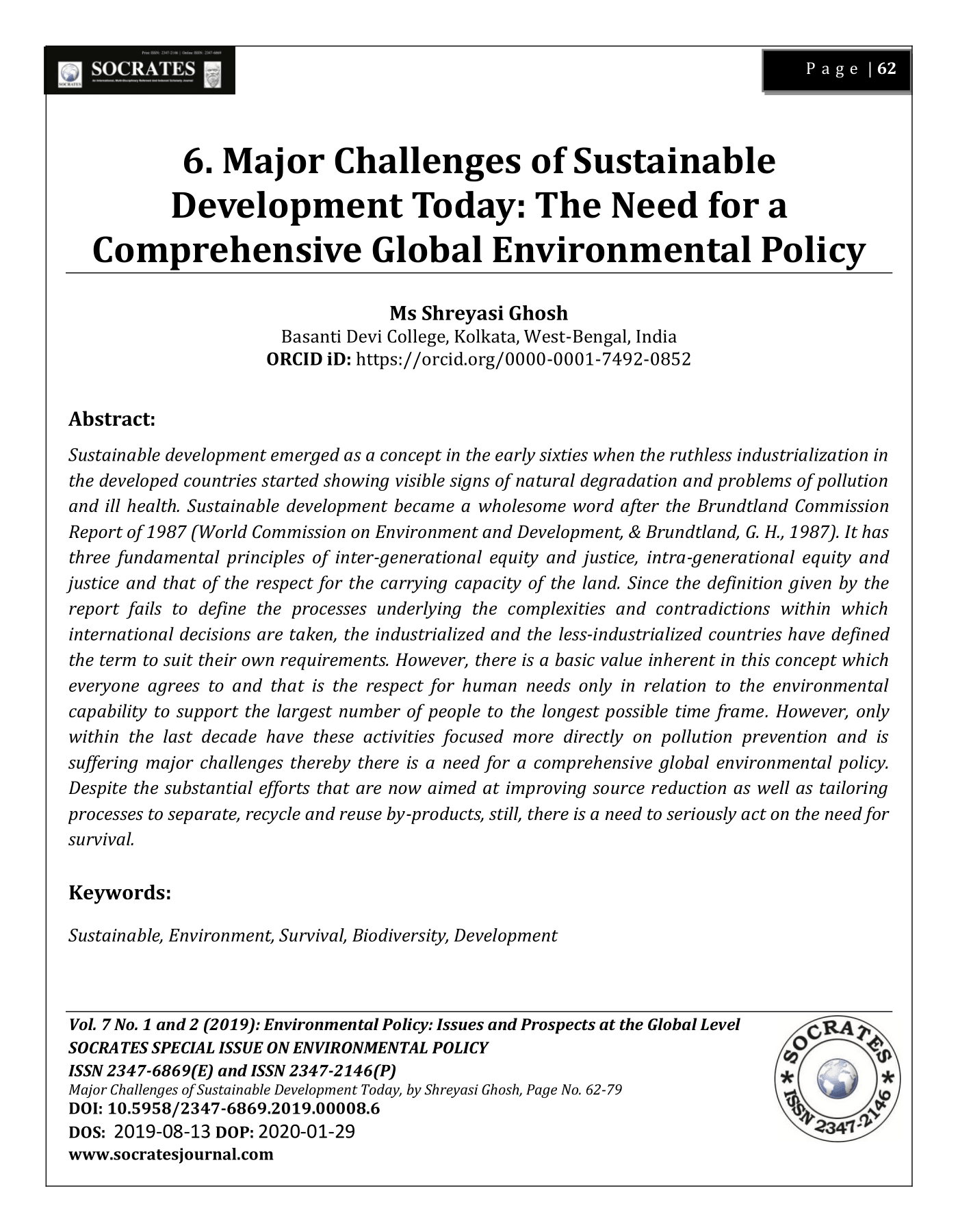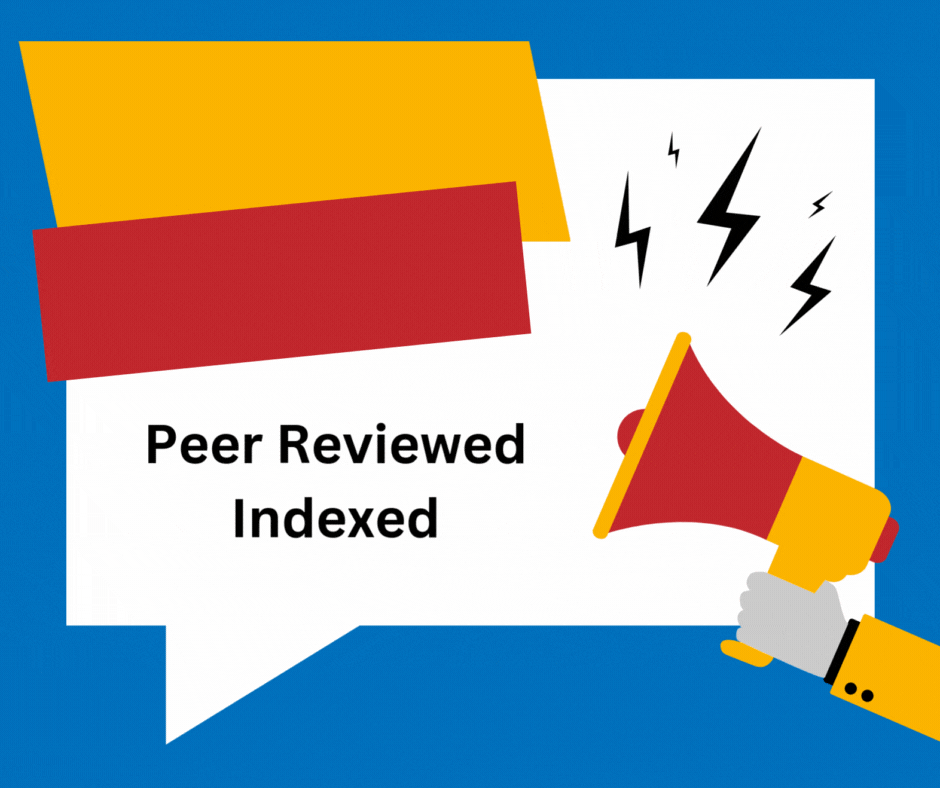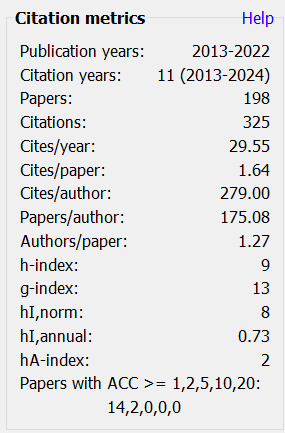Major Challenges of Sustainable Development Today
The Need for a Comprehensive Global Environmental Policy
DOI:
https://doi.org/10.5958/2347-6869.2019.00008.6Keywords:
Sustainable, Environment, Survival, Biodiversity, DevelopmentAbstract
Sustainable development emerged as a concept in the early sixties when the ruthless industrialization in the developed countries started showing visible signs of natural degradation and problems of pollution and ill health. Sustainable development became a wholesome word after the Brundtland Commission Report of 1987 (World Commission on Environment and Development, & Brundtland, G. H., 1987). It has three fundamental principles of inter-generational equity and justice, intra-generational equity and justice and that of the respect for the carrying capacity of the land. Since the definition given by the report fails to define the processes underlying the complexities and contradictions within which international decisions are taken, the industrialized and the less-industrialized countries have defined the term to suit their own requirements. However, there is a basic value inherent in this concept which everyone agrees to and that is the respect for human needs only in relation to the environmental capability to support the largest number of people to the longest possible time frame. However, only within the last decade have these activities focused more directly on pollution prevention and is suffering major challenges thereby there is a need for a comprehensive global environmental policy. Despite the substantial efforts that are now aimed at improving source reduction as well as tailoring processes to separate, recycle and reuse by-products, still, there is a need to seriously act on the need for survival.
DOI: 10.5958/2347-6869.2019.00008.6
Downloads
Metrics
References
Annandale, D., & Taplin, R. (2003). Is environmental impact assessment regulation a ‘burden’to private firms?. Environmental impact assessment review, 23(3), 383-397.
Azapagic, A. (2004). Developing a framework for sustainable development indicators for the mining and minerals industry. Journal of cleaner production, 12(6), 639-662.
Basiago, A. D. (1995). Methods of defining ‘sustainability’. Sustainable development, 3(3), 109-119. Basiago, A. D. (1996). The search for the sustainable city in 20th century urban planning. Environmentalist, 16(2), 135-155.
Boyle, A. (1995). Human Right Approaches to Environmental Protection: Unnecessary, Undesirable and Unethical. Remarks delivered at the Research Centre for International Law, University of Cambridge.
Dixon, J. A., & Fallon, L. A. (1989). The concept of sustainability: origins, extensions, and usefulness for policy. Society & Natural Resources, 2(1), 73-84.
DNV-GL, UN Global Compact, Monday Morning-Global Institute (2016), Global Opportunity Report 2016.
Eblen, R. A., & Eblen, W. R. (1994). Encyclopedia of the Environment. Houghton Mifflin Co..
ILO. (2015). Guidelines for a just transition towards environmentally sustainable economies and societies for all.
Jeffery, M. (2005). Environmental Governance: A comparative analysis of public participation and access to justice. Available at SSRN 1126440.
Programme des Nations Unies pour l'environnement. (2010). Metal stocks in society: scientific synthesis. UNEP DTIE
Swiss Re SONAR (2015), New Emerging Risk Insights. Available online at http://media.swissre.com/documents/ SONAR_2015_WEB.pdf
WCED (1987) Our Common Future. World Commission on Environment and Development. Oxford: Oxford University Press
World Bank (1986) Environmental Aspects of Bank Work. The World Bank Operations Manual Statements, OMS 2.36. Washington, DC: World Bank.
World Commission on Environment and Development, & Brundtland, G. H. (1987). Presentation of the Report of the World Commission on Environment and Development to the Commission of the European Communities, the EC and EFTA Countries... 5 May 1987, Brussels. World Commission on Environment and Development.

Downloads
Published
How to Cite
Issue
Section
Categories
License
Copyright (c) 2020 Ghosh Shreyasi

This work is licensed under a Creative Commons Attribution-NonCommercial 4.0 International License.
Revised Copyright/CC license that applies to all the articles published after 05-02-2017
Attribution-NonCommercial 4.0 International (CC BY-NC 4.0)

Copyright/CC license that applies to all the articles published before 05-02-2017
Attribution-Non Commercial-No Derivatives 4.0 International (CC BY-NC-ND 4.0)

Author(s) will retain all the right except commercial and re-publishing rights. In the case of re-publishing, they will have to obtain written permission from the journal. Additional licensing agreements (Creative Commons licenses) grants rights to readers to copy, distribute, display and perform the work as long as you give the original author(s) credit, they can not use the works for commercial purposes and are not allowed to alter, transform, or build upon the work. For any reuse or distribution, readers and users must make clear to others the license terms of this work. Any of these conditions can be waived if you get permission from the copyright holders. Nothing in this license impairs or restricts the authors’ rights. To view a copy of this license, visit http://creativecommons.org/licenses/by-nc-nd/4.0/ or send a letter to Creative Commons, 171 Second Street, Suite 300, San Francisco, California, 94105, USA.
Research Papers published in SOCRATES are licensed under an Attribution-NonCommercial-NoDerivatives 4.0 International (CC BY-NC-ND 4.0)
















